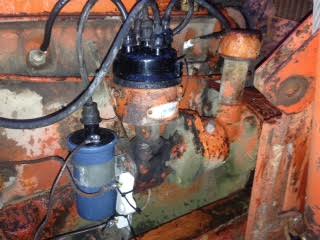WD No Spark
Printed From: Unofficial Allis
Category: Allis Chalmers
Forum Name: Farm Equipment
Forum Description: everything about Allis-Chalmers farm equipment
URL: https://www.allischalmers.com/forum/forum_posts.asp?TID=112154
Printed Date: 17 Dec 2025 at 2:54pm
Software Version: Web Wiz Forums 11.10 - http://www.webwizforums.com
Topic: WD No Spark
Posted By: mksteckel
Subject: WD No Spark
Date Posted: 18 Sep 2015 at 7:38pm
|
New here and I really need some help. I bought a 1948 WD that's been sitting for a few years. It didn't have spark when I started working on it. It had a 12v conversion already with a 12v generator. I've since replaced cap, rotor, condenser, coil, resistor, and points. I have power through resistor, coil, up to points and out the end of the rotor but no spark or power through cap. I'm stumped. Here is a pic of the set up  |
Replies:
Posted By: mksteckel
Date Posted: 18 Sep 2015 at 7:39pm
|
Here is another pic of the set up.. Don't know if it helps y'all when it comes to advice  |
Posted By: DougS
Date Posted: 18 Sep 2015 at 7:44pm
|
Do you have 12 volts at the coil input? Even with the points closed? If not, check your ignition switch. If you do, disconnect the wire to your points and ground that coil stud with a short piece of wire. When you remove the wire, a spark should shoot from the high voltage wire. Have that wire within a quarter inch of a ground. If this works, get back to me. |
Posted By: Dmpaul89
Date Posted: 18 Sep 2015 at 8:22pm
| Id swap old parts in and see if it makes a difference. One at time. Dont know what brand parts you bought but i havent been very pleased with the cheap kits they sell in farm and home stores. They are very crude and sometimes need tweaking to work. Ive found that most the time an old tractor just needs the points sanded on to spark. |
Posted By: Chalmersbob
Date Posted: 18 Sep 2015 at 8:33pm
|
I always start with a jumper wire from the battery to the coil. That eliminates the switch circuit. I've done this already and the tractor started, removed the wire and the tractor died. Tried it again, and it kept running and has been running since. LOL Bob ------------- 4 B's, 1 C's,3 CA's, 2 G's WD, D14, D15, B-1, B10, B12, 712S, |
Posted By: Gerald J.
Date Posted: 18 Sep 2015 at 8:44pm
|
From a post I made about 7 weeks ago. Anything in the ignitions system can go wrong. From a post I made a couple weeks ago: Sitting a while points sometimes corrode and don't make contact even when the close. Or I've had points on a running engine stop moving because of lack of lubrication on the point pivot. Fact is everything in the ignition system has to be right for it to run and any part can stop it. Points, condenser, coil, wires, ignition switch, distributor advance, rotor, cap and I've had trouble with nearly every one of these some time.
|
Posted By: Allen Dilg
Date Posted: 18 Sep 2015 at 9:27pm
| Hello Mkstetkel Just reading your post and Shooten from the HIP I'd say the carbon was not in the center of the CAP |
Posted By: mksteckel
Date Posted: 19 Sep 2015 at 11:42am
| Well I found I had a bad wire and I didn't have points gapped correctly. Got it fired up this morning for the first time in around 5 years. |
Posted By: fixer1958
Date Posted: 20 Sep 2015 at 9:46am
|
I had that happen once on my WD. We were snowed in/blading snow, and I stopped to go in the house to get something. Came back out and no start/no spark. Good spark out of the coil but stopped there. Looked at the cap and the button that connects to the rotor fell out. I couldn't get out to get a new cap so I wadded up a piece of tin foil and crammed it in the hole and got the job done. |